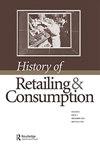The toyshop, the cabinet, and eighteenth-century curiosity
Q2 Arts and Humanities
引用次数: 0
Abstract
ABSTRACT Although toyshops survived in name, eighteenth-century toyshops were retail environments distinct to that period, situated alongside other luxury retailers in many of Britain’s urban centres. They sold a range of adornments and collectibles, but the repeated referral to their contents as ‘curiosities’ raises questions as to how toyshops related to other spaces associated with curious articles, such as cabinets of curiosity. As retail sites, toyshops were part of consumer changes, whereas cabinets housed collectibles more associated with enlightened enquiry, so are often separated in the historiography. This survey considers toyshops in London and Birmingham, both in what they sold and their approaches to displaying and promoting these goods, in relation to the contents and experience in cabinets. This juxtaposes two forms of acquisition, collecting and consumption, and situates objects associated with knowledge acquisition and ‘trifling’ in the same discussion. Furthermore, the increasing emphasis on polite shopping is considered with reference to continuing requirements for attracting custom, which could be enhanced through exciting curiosity.玩具店,橱柜,还有18世纪的好奇心
尽管玩具店在名义上幸存了下来,但18世纪的玩具店是与那个时期截然不同的零售环境,与英国许多城市中心的其他奢侈品零售商并列。他们出售一系列装饰品和收藏品,但反复提到他们的内容是“好奇”,这引发了一个问题,即玩具店如何与其他与好奇物品相关的空间联系起来,比如好奇柜。作为零售场所,玩具店是消费者变化的一部分,而橱柜里的收藏品更多地与开明的询问有关,因此在历史编纂中往往是分开的。这项调查考虑了伦敦和伯明翰的玩具店,包括他们销售的产品和他们展示和推广这些产品的方法,以及橱柜里的内容和体验。这并置了两种形式的获取,收集和消费,并将与知识获取和“琐事”相关的对象置于同一讨论中。此外,越来越强调礼貌的购物被认为是与吸引顾客的持续要求有关,这可以通过激发好奇心来加强。
本文章由计算机程序翻译,如有差异,请以英文原文为准。
求助全文
约1分钟内获得全文
求助全文
来源期刊

History of Retailing and Consumption
Arts and Humanities-History
CiteScore
0.50
自引率
0.00%
发文量
3
 求助内容:
求助内容: 应助结果提醒方式:
应助结果提醒方式:


